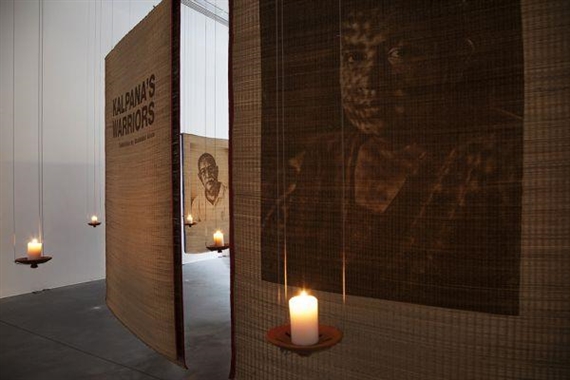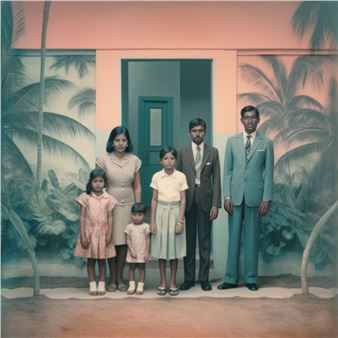Shahidul Alam: Kalpana's Warriors
NEPN and Breeze Creatives present KalpanaвҖҷs Warriors, an
exhibition by the acclaimed Bangladeshi photographer, artist and activist
Shahidul Alam, during this AutumnвҖҷs Freedom City 2017
celebration.
Kalpana Chakma was a vocal and charismatic leader who campaigned for
the rights of indigenous people in the Chittagong Hill Tracts area of
Bangladesh.
She was abducted from her home at gunpoint 20 years ago by a military
officer and two members of the Village Defence Party and has never been seen
again.Through this powerful installation, using photographs printed on large
straw mats each one illuminated by a candle, Alam attempts to break the silence
surrounding her disappearance.
Kalpana, who was only 23 when she was abducted, had made it her lifeвҖҷs
mission to campaign for the rights of the indigenous people living in the
Chittagong Hill Tracts (CHT). She belonged to the Chakma or Pahari community,
and was a leader of the Hill WomenвҖҷs Federation.
The ethnic conflict in the CHT, which began in 1977 soon after the
Bangladesh state came into being, continues to this day in spite of a peace
treaty negotiated in 1997 between the state and the Pehari people. Amnesty
International reports that more than 100,000 Pahari have been displaced by the
conflict. There have been multiple reports of human rights violations, massacres
and the razing of entire villages by Bangladeshi forces.
The portraits of KalpanaвҖҷs warriors вҖ“ those who have refused to let go of
her memory and legacy вҖ“ were created using laser etching on straw mats. This
innovative technique, developed specifically for this exhibition, is rooted in
the everyday realities of the people and the sparse conditions of KalpanaвҖҷs home
where she slept on the floor on a straw mat. Shahidul Alam said he wanted the
portraits to be burned onto the straw mats by a laser beam to remind the viewer
of the fires deliberately set by the authorities who had burnt the Pahari
villages вҖ“ something that Kalpana was protesting about in her last confrontation
with the military.
вҖңI have never met Kalpana Chakma, I only knew her in terms of her
activism but I feel I know her in other ways. I have sat on her bed, read her
diaries, spent time with her family, and I have looked at archival footage of
her talks. But more importantly, I have felt her presence among the people who
surviveвҖҰ
Because of the situation of the workers, a laser device which is used in
the garment industry being appropriated for something like this was for me very
apt, because I think as artists we need to appropriate the spaces, we need to
turn things around. ItвҖҷs guerrilla warfare and in guerrilla warfare you have to
use the enemyвҖҷs strength against them, which is what we are trying to do. I
wanted the process itself to deal with the politics.вҖқ Shahidul
Alam 2016.
The exhibition is presented by NEPN and Breeze Creatives with the kind
support of Autograph ABP, Shahidul Alam, Arts Council England, DRIK Picture
Library Bangladesh and the Northern Centre of Photography at the University of
Sunderland. The exhibition was first shown in the UK at Autograph ABP in Spring
2016.

NEPN and Breeze Creatives present KalpanaвҖҷs Warriors, an
exhibition by the acclaimed Bangladeshi photographer, artist and activist
Shahidul Alam, during this AutumnвҖҷs Freedom City 2017
celebration.
Kalpana Chakma was a vocal and charismatic leader who campaigned for
the rights of indigenous people in the Chittagong Hill Tracts area of
Bangladesh.
She was abducted from her home at gunpoint 20 years ago by a military
officer and two members of the Village Defence Party and has never been seen
again.Through this powerful installation, using photographs printed on large
straw mats each one illuminated by a candle, Alam attempts to break the silence
surrounding her disappearance.
Kalpana, who was only 23 when she was abducted, had made it her lifeвҖҷs
mission to campaign for the rights of the indigenous people living in the
Chittagong Hill Tracts (CHT). She belonged to the Chakma or Pahari community,
and was a leader of the Hill WomenвҖҷs Federation.
The ethnic conflict in the CHT, which began in 1977 soon after the
Bangladesh state came into being, continues to this day in spite of a peace
treaty negotiated in 1997 between the state and the Pehari people. Amnesty
International reports that more than 100,000 Pahari have been displaced by the
conflict. There have been multiple reports of human rights violations, massacres
and the razing of entire villages by Bangladeshi forces.
The portraits of KalpanaвҖҷs warriors вҖ“ those who have refused to let go of
her memory and legacy вҖ“ were created using laser etching on straw mats. This
innovative technique, developed specifically for this exhibition, is rooted in
the everyday realities of the people and the sparse conditions of KalpanaвҖҷs home
where she slept on the floor on a straw mat. Shahidul Alam said he wanted the
portraits to be burned onto the straw mats by a laser beam to remind the viewer
of the fires deliberately set by the authorities who had burnt the Pahari
villages вҖ“ something that Kalpana was protesting about in her last confrontation
with the military.
вҖңI have never met Kalpana Chakma, I only knew her in terms of her
activism but I feel I know her in other ways. I have sat on her bed, read her
diaries, spent time with her family, and I have looked at archival footage of
her talks. But more importantly, I have felt her presence among the people who
surviveвҖҰ
Because of the situation of the workers, a laser device which is used in
the garment industry being appropriated for something like this was for me very
apt, because I think as artists we need to appropriate the spaces, we need to
turn things around. ItвҖҷs guerrilla warfare and in guerrilla warfare you have to
use the enemyвҖҷs strength against them, which is what we are trying to do. I
wanted the process itself to deal with the politics.вҖқ Shahidul
Alam 2016.
The exhibition is presented by NEPN and Breeze Creatives with the kind
support of Autograph ABP, Shahidul Alam, Arts Council England, DRIK Picture
Library Bangladesh and the Northern Centre of Photography at the University of
Sunderland. The exhibition was first shown in the UK at Autograph ABP in Spring
2016.
Artists on show
Contact details


 ARTISTS
ARTISTS










